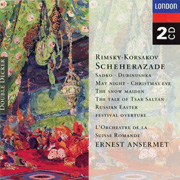
Rimsky-Korsakov: Scheherazade
L’Orchestre de la Suisse Romande
Ernest Ansermet
1994: Decca 443 464-2
CD 1
Scheherazade
The tale of Tsar Saltan (suite), Op. 57
from The tale of Tsar Saltan
CD 2
* with the Motet Choir of Geneva (conductor: Jacques Horneffe)
Although I have never been a big fan of “Sheherazade” (possibly because of having to learn to play its catchiest theme on a xylophone for a college theatre production of “You Can’t Take It With You”), it really is a sumptuous feast provided you can take the time to really tuck into it in full. There are orgasmically powerful elements such as the battallion of French horns in intense acrobatic explosion amid the tumult of the end of the Kalandar Prince segment, and at the other end of the orgasm there are the exquisite violin statements of the theme (best of all the opening of the second section, where the violin voices intertwining harmonic aspects of the theme so achingly), all balanced by everything from quaint folkloric elements and easy stagecraft to tantalizing sideshows and grand romantic sweeps.
The recording on this CD is magnificent overall (although the percussionist charged with the tambourine doesn’t match the cymbalist on the precision neede for the quick stuff a third of the way into the fourth track)…and if I were the conductor I probably would have collapsed in a rapturously grateful heap on the podium after the phenomenally powerful climax of the Kalandar Prince story.
It’s musical storytelling every bit as broad as “Peter and the Wolf” or “Tyl Eulenspiegel,” but decidedly more adult and musky. Its ending is sneaky, seeming to offer a surprise wallop that never comes (perhaps that’s an allusion to Sheherazade not getting her head chopped off and all ending peacefully after all), which leaves the final impression as dreamlike as bedtime stories do. But within that tale—OH what adventures and raptures!!
Comments © 2005 Mark Ellis Walker, except as noted, and no claim is made to the images and quoted lyrics.